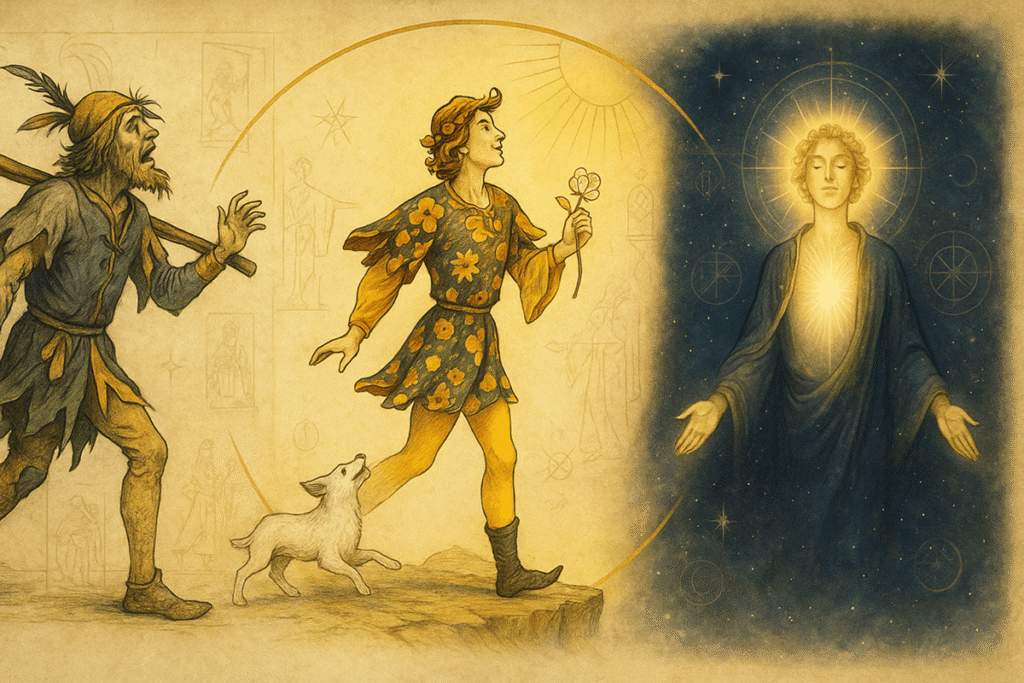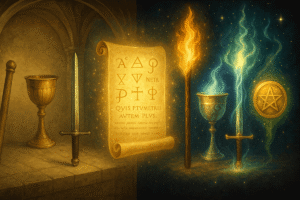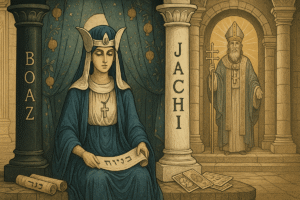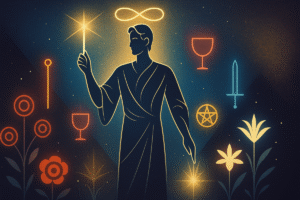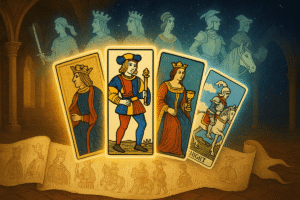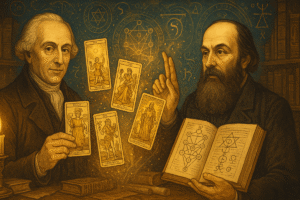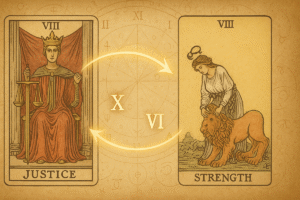Table of Contents
The Fool card occupies perhaps the most intriguing position in the tarot deck. Neither fully part of the Major Arcana’s numerical sequence nor entirely separate from it, this enigmatic figure has undergone one of the most fascinating transformations in the history of divination systems. When I first encountered The Fool years ago, I’ll admit I was puzzled by its seemingly contradictory nature. How could a card representing folly also symbolize new beginnings?
The answer, I’ve come to understand, lies in tracing the card’s remarkable journey through time. From its origins as a wild card in medieval Italian gaming tables to its current role as the spiritual seeker’s first step, The Fool’s evolution mirrors our own changing relationship with wisdom, madness, and the courage to embark on unknown paths.
The Medieval Origins of Il Matto
To understand The Fool’s transformation, we must first travel back to 15th century Italy, where tarot emerged not as a mystical practice but as an elaborate card game called tarocchi. In these early decks, The Fool appeared as “il matto” or “The Madman,” a figure that operated outside the normal hierarchy of the trump cards.
What strikes me most about these early depictions is how different they feel from our modern interpretations. Il matto was often portrayed as a disheveled vagrant, sometimes carrying a club or stick, wandering aimlessly with torn clothes and a vacant expression. This wasn’t the optimistic seeker we know today, but rather a representation of society’s outcasts, those who existed on the margins of medieval social order.
The card’s function in the game was equally unconventional. Unlike other trump cards, il matto could be played at any time but rarely won tricks. Instead, it served as a kind of escape card, allowing players to avoid following suit when they had no other options. Perhaps there’s something profound in this original function that we’ve overlooked. The fool, even then, represented a way out of conventional constraints.
These early depictions weren’t entirely negative, though. Medieval society had a complex relationship with madness and folly. Court jesters, after all, were often the only people who could speak truth to power. There’s a fascinating duality here that I think we sometimes miss in modern interpretations. The fool was simultaneously the lowest and the most liberated figure in society.
The Renaissance Transformation
As tarot spread beyond Italy and the Renaissance brought new ways of thinking about human nature and spirituality, The Fool began to evolve. The stark medieval madman started to acquire more nuanced characteristics. Artists began depicting the figure with more dignity, though still maintaining that essential quality of existing outside normal social boundaries.
During this period, I believe we see the first hints of The Fool as a spiritual archetype rather than merely a social outcast. Renaissance humanist thinking placed greater emphasis on individual experience and the journey of self-discovery. This philosophical shift created fertile ground for reimagining The Fool not as someone who had lost their way, but as someone who had chosen a different path entirely.
The influence of Christian mysticism during this era cannot be understated either. The concept of “holy fools” or “fools for Christ” provided a religious framework for understanding how apparent foolishness might actually represent profound wisdom. Saints who deliberately chose poverty and simplicity over worldly success offered a model for The Fool as a spiritual seeker rather than a mere vagrant.
Yet the transformation wasn’t complete or uniform. Different regions and deck creators maintained varying interpretations. Some preserved the medieval emphasis on madness and social disruption, while others began incorporating symbols that suggested journey and purpose. This inconsistency, I think, actually enriches our understanding of how symbolic meanings evolve gradually rather than through sudden revelation.
The Occult Revival and Spiritual Reframing
The real transformation of The Fool card occurred during the 19th century occult revival, when figures like Éliphas Lévi, the Hermetic Order of the Golden Dawn, and later Arthur Edward Waite fundamentally reconceptualized tarot’s purpose and meaning. This period marks perhaps the most dramatic shift in The Fool’s evolution, one that continues to influence how we understand the card today.
Lévi’s contributions were particularly significant. He connected tarot to Hebrew mysticism and the Kabbalah, suggesting that the cards represented a complete system of esoteric knowledge. Under this interpretation, The Fool became not a random wild card but the beginning of a carefully structured spiritual journey. The unnumbered card that once disrupted game play now represented the soul before incarnation, pure potential preparing to enter the material world.
The Golden Dawn expanded on these ideas, developing what we now call the “Fool’s Journey” concept. This framework positions The Fool as the protagonist of the Major Arcana’s story, a spiritual seeker who encounters various archetypal experiences on the path to enlightenment. When I first learned about this interpretation, it completely changed how I viewed not just The Fool but the entire tarot system.
Waite’s Rider-Waite deck, published in 1909, cemented many of these changes in visual form. His Fool is young, well-dressed, and carries symbols of journey and new beginning. The cliff edge represents faith and the willingness to step into the unknown. The small dog at his feet might represent either instinct warning of danger or loyalty accompanying the journey. These symbols created a template that most modern decks still follow, though I sometimes wonder if we’ve lost some of the original complexity in the process.
Psychological and Modern Interpretations
The 20th century brought psychological frameworks to tarot interpretation, further transforming The Fool’s meaning. Carl Jung’s work on archetypes and the collective unconscious provided new ways to understand the card’s symbolic power. The Fool became associated with the part of the psyche that remains open to new experiences, unencumbered by past conditioning or future fears.
Modern interpretations often emphasize The Fool’s connection to authenticity and spontaneity. In our increasingly structured and predictable world, The Fool represents the courage to act without guarantees, to embrace uncertainty as a necessary part of growth. This resonates differently than it might have in medieval times when uncertainty was an unwelcome constant in most people’s lives.
I find it interesting how contemporary readers often struggle with The Fool’s more challenging aspects. The card’s association with naivety, poor judgment, and reckless behavior hasn’t disappeared entirely, but it’s often minimized in favor of more comfortable interpretations about new beginnings and spiritual seeking. Perhaps this reflects our modern discomfort with genuine folly or our tendency to pathologize behaviors that don’t fit conventional success models.
The digital age has brought yet another layer to The Fool’s evolution. Online communities and social media have created new ways to share and develop interpretations. I’ve noticed that The Fool often appears in discussions about taking creative risks, leaving toxic relationships, or pursuing unconventional career paths. The card has become a symbol of resistance to societal pressure and corporate conformity.
What This Evolution Reveals About Us
Tracing The Fool’s journey from medieval wild card to modern spiritual archetype reveals as much about human consciousness as it does about tarot symbolism. Each era has projected its own understanding of wisdom, madness, and spiritual seeking onto this enigmatic figure.
The medieval il matto reflected a society’s anxiety about social order and the fear of existing outside established hierarchies. The Renaissance began to see dignity in choosing an alternative path. The occult revival of the 19th century transformed the outsider into the spiritual seeker. Our contemporary interpretations emphasize psychological authenticity and the courage to pursue individual truth.
What remains consistent, I believe, is The Fool’s essential function as a mirror for examining our relationship with uncertainty, risk, and the unknown. Whether we see the card as representing divine madness, spiritual seeking, or psychological authenticity may depend more on our current needs and cultural context than on any inherent meaning within the symbol itself.
This evolution continues today. New deck creators regularly reimagine The Fool, sometimes as a gender-neutral figure, sometimes with different cultural symbols, sometimes in futuristic or fantasy settings. Each iteration adds another layer to the card’s meaning while preserving its core function as a representation of beginnings, potential, and the willingness to step beyond familiar boundaries.
Perhaps that’s the most profound aspect of The Fool’s evolution. The card itself embodies the very quality it represents – the ability to remain open to transformation, to continually become something new while retaining essential characteristics. In studying how The Fool has changed over centuries, we might discover insights about our own capacity for growth and reinvention.
The journey from il matto to spiritual seeker reflects humanity’s evolving understanding of what it means to live authentically in an uncertain world. As we continue to face new challenges and opportunities, The Fool card will likely continue evolving, always ready to step off the next cliff into whatever wisdom awaits.
Frequently Asked Questions
Why is The Fool numbered zero instead of one?
The numbering of The Fool as zero emerged gradually and carries layered symbolism. In original tarot games, The Fool was unnumbered because it functioned outside the trump hierarchy as a wild card. When occultists like Waite began assigning numbers in the early 20th century, zero was chosen to represent unlimited potential, the void before creation, and the soul before incarnation. The circle shape of zero also mirrors concepts of completion and cycles, suggesting The Fool exists both at the beginning and end of the spiritual journey simultaneously.
Did The Fool card inspire the modern Joker in playing cards?
While The Fool and the Joker share similarities, their connection is more parallel evolution than direct lineage. The Fool functioned as a wild card in Italian tarot games from the 15th century, while the Joker appears to have developed independently in American card games like Euchre during the 1850s. Both cards serve similar functions as wild cards that exist outside normal suit hierarchies, which likely reflects a common need in card game design rather than one directly inspiring the other.
What did “il matto” actually mean to medieval players?
To medieval and Renaissance players, “il matto” translated as both “the madman” and “the beggar,” representing someone who existed on society’s margins. The card depicted actual social outcasts of the time, often shown in ragged clothing, barefoot, or being harassed by dogs and children. While we sometimes romanticize the medieval fool, the original imagery was quite harsh, showing someone who had fallen from social grace rather than someone on a spiritual quest. This reflects the medieval fear of poverty and social exclusion that dominated that era’s worldview.
When did people start calling it the Fool’s Journey?
The concept of the “Fool’s Journey” as a narrative framework for the Major Arcana didn’t emerge until surprisingly recently. Eden Gray popularized this phrase in her 1970 book “A Complete Guide to the Tarot,” though the conceptual groundwork was laid by the 19th century occult revival. Before this, tarot cards were primarily game pieces or individual symbols for fortune telling, not chapters in a unified story. This modern narrative interpretation reflects our contemporary preference for seeing life as a journey of self-discovery rather than as fixed fate or random chance.

